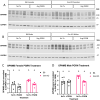Investigating the role and regulation of GPNMB in progranulin-deficient macrophages
- PMID: 39391322
- PMCID: PMC11464288
- DOI: 10.3389/fimmu.2024.1417836
Investigating the role and regulation of GPNMB in progranulin-deficient macrophages
Abstract
Introduction: Progranulin (PGRN) is a holoprotein that is internalized and taken to the lysosome where it is processed to individual granulins (GRNs). PGRN is critical for successful aging, and insufficient levels of PGRN are associated with increased risk for developing neurodegenerative diseases like AD, PD, and FTD. A unifying feature among these diseases is dysregulation of peripheral immune cell populations. However, considerable gaps exist in our understanding of the function(s) of PGRN/GRNs in immune cells and their role in regulating central-peripheral neuroimmune crosstalk. One of the most upregulated genes and proteins in humans with GRN haploinsufficiency and in aged Grn knock-out (KO) mice is glycoprotein non-metastatic B (GPNMB) but its normal role within the context of immune crosstalk has not been elucidated.
Methods: To address this gap, peritoneal macrophages (pMacs) from 5-to-6-month old WT and Grn KO mice were assessed for Gpnmb expression and stimulation-dependent cytokine release in the presence or absence of the Gpnmb extracellular domain (ECD). Cellular localization, as well as inhibition of, the microphthalmia-associated transcription factor (MITF) was assessed to determine its mechanistic role in Gpnmb overexpression in Grn KO pMacs.
Results: We observed an increase in GPNMB protein and mRNA as a result of insufficient progranulin in peripheral immune cells at a very early age relative to previous reports on the brain. Stimulation-dependent cytokine release was decreased in the media of Grn KO pMacs relative to WT controls; a phenotype that could be mimicked in WT pMacs with the addition og GPNMB ECD. We also found that MITF is dysregulated in Grn KO pMacs; however, its nuclear translocation and activity are not required to rescue the immune dysregulation of Grn KO macrophages, suggesting redundancy in the system.
Discussion: These findings highlight the fact that knowledge of early-stage disease mechanism(s) in peripheral populations may inform treatment strategies to delay disease progression at an early, prodromal timepoint prior to development of neuroinflammation and CNS pathology.
Keywords: GPNMB; MITF; inflammation; macrophage; progranulin.
Copyright © 2024 Gillett, Neighbarger, Cole, Wallings and Tansey.
Conflict of interest statement
The authors declare that the research was conducted in the absence of any commercial or financial relationships that could be construed as a potential conflict of interest.
Figures






Update of
-
Investigating the Role and Regulation of GPNMB in Progranulin-deficient Macrophages.bioRxiv [Preprint]. 2024 Mar 14:2024.03.12.584649. doi: 10.1101/2024.03.12.584649. bioRxiv. 2024. Update in: Front Immunol. 2024 Sep 26;15:1417836. doi: 10.3389/fimmu.2024.1417836. PMID: 38558966 Free PMC article. Updated. Preprint.
Similar articles
-
ASO-mediated knock-down of GPNMB in mutant-GRN and in Grn-deficient peripheral myeloid cells disrupts lysosomal function and immune responses.Mol Neurodegener. 2025 Apr 8;20(1):41. doi: 10.1186/s13024-025-00829-w. Mol Neurodegener. 2025. PMID: 40200337 Free PMC article.
-
Progranulin loss results in sex-dependent dysregulation of the peripheral and central immune system.Front Immunol. 2022 Dec 22;13:1056417. doi: 10.3389/fimmu.2022.1056417. eCollection 2022. Front Immunol. 2022. PMID: 36618392 Free PMC article.
-
Investigating the Role and Regulation of GPNMB in Progranulin-deficient Macrophages.bioRxiv [Preprint]. 2024 Mar 14:2024.03.12.584649. doi: 10.1101/2024.03.12.584649. bioRxiv. 2024. Update in: Front Immunol. 2024 Sep 26;15:1417836. doi: 10.3389/fimmu.2024.1417836. PMID: 38558966 Free PMC article. Updated. Preprint.
-
Progranulin and GPNMB: interactions in endo-lysosome function and inflammation in neurodegenerative disease.J Neuroinflammation. 2023 Nov 30;20(1):286. doi: 10.1186/s12974-023-02965-w. J Neuroinflammation. 2023. PMID: 38037070 Free PMC article. Review.
-
Progranulin as a therapeutic target for dementia.Expert Opin Ther Targets. 2018 Jul;22(7):579-585. doi: 10.1080/14728222.2018.1487951. Epub 2018 Jun 22. Expert Opin Ther Targets. 2018. PMID: 29889573 Review.
Cited by
-
ASO-mediated knock-down of GPNMB in mutant-GRN and in Grn-deficient peripheral myeloid cells disrupts lysosomal function and immune responses.Mol Neurodegener. 2025 Apr 8;20(1):41. doi: 10.1186/s13024-025-00829-w. Mol Neurodegener. 2025. PMID: 40200337 Free PMC article.
References
-
- Galimberti D, Fumagalli G, Fenoglio C, Cioffi S, Arighi A, Serpente M, et al. . Progranulin plasma levels predict the presence of GRN mutations in asymptomatic subjects and do not correlate with brain atrophy: results from the GENFI study. Neurobiol Aging. (2018) 62:245.e9–12. doi: 10.1016/j.neurobiolaging.2017.10.016 - DOI - PMC - PubMed
MeSH terms
Substances
Grants and funding
LinkOut - more resources
Full Text Sources
Molecular Biology Databases
Research Materials
Miscellaneous

